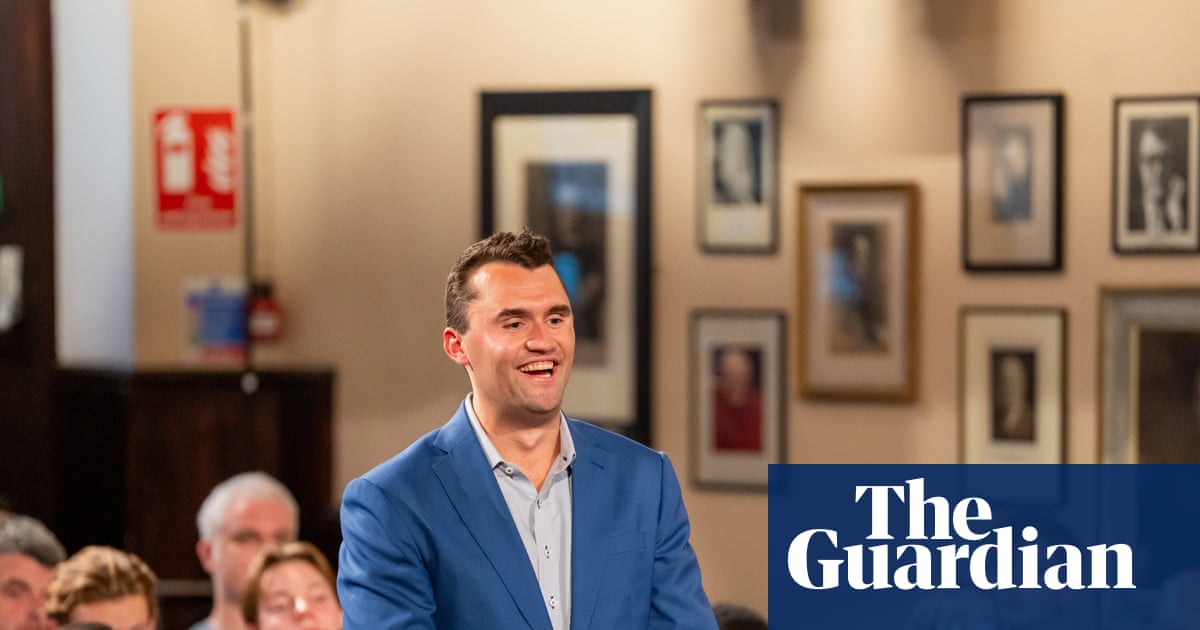In her new book, the Harvard history professor and New Yorker writer Jill Lepore makes a 600-page case for the US constitution as a living document, made to be amended by each generation.
Lepore said her book, We the People, is also “a deep historical critique of originalism”, the conservative legal theory that dominates the supreme court, deep political polarization having rendered constitutional amendments all but politically impossible.
Among originalists, only the views of those who wrote the constitution in Philadelphia in 1787 should be used to divine constitutional meaning, even 250 years later in a country of cars, planes, automatic weapons, AI, rights for women and minorities and all the founders did not know.
To Lepore, as to many scholars, that is clearly absurd.
“Originalism is a weird bucket that contains multitudes,” Lepore said, from her study in Cambridge, Massachusetts. “But among the more simplistic versions of originalism is the insistence that this is how the constitution was written and was meant to be read from the very beginning: that you can only refer to James Madison’s constitution itself, Madison’s notes, the notes of the ratifying convention, the Federalist Papers, and that’s pretty much it.
“Madison’s notes, like everyone else’s notes, were not published until 1840. He died in 1837. Everybody took a 50-year vow of secrecy, and you weren’t supposed to say what happened at the Constitutional Convention because it wasn’t supposed to matter [regarding] how to interpret the constitution.
“The ratifying convention debates, some were published soon after the [state] conventions. They’re not especially definitive, not full accounts. The Federalist Papers” – essays on the constitution, written by Madison, Alexander Hamilton and John Jay – “were published really only in New York newspapers in 1787 and 1788. They were not widely read outside New York … they’re not really cited by the supreme court for a very long time.
“So the idea that there is this primary text of historical documents that from the beginning were used to read the constitution is just not a defensible position.”
Regardless, the originalist justices proceed, removing rights, facilitating a lawless president. As they do, they might consider a minor but potent irony, presented by Lepore.
In 1982, conservative students from Yale and Chicago founded the Federalist Society, a group that would become an engine of originalist thought, five of six current rightwing justices among its paid-up members. For a logo, the group chose Madison’s silhouette. But the Federalists were not true to their originalist creed. Finding Madison’s silhouette displeasing, they amended it, to give him a nicer nose.
“I really wanted to put the nose in there,” Lepore said, laughing. “If you look at the logo of the Federalist Society, Madison just looks classically handsome. And I think Madison was, like, about 5ft tall, and he didn’t have an especially attractive profile. I greatly admire Madison. We all have physical faults. But that was one funny detail. I think it was Robert Bork’s son who said, ‘Let’s just tidy him up.’”
Madison’s actual nose was scarred by frostbite. Bork, a formidable judge and jurist, was scarred by a failed supreme court nomination in 1987, under Ronald Reagan. He died in 2012, four years before another originalist titan, justice Antonin Scalia. Their ghosts hover still.

In any circumstance, a new Lepore book is big news. In 2018 she enjoyed bestselling success with These Truths, an inclusive American history. We the People looks and reads like a sequel, though there have been two books in between: If/Then, a history of early computing, and The Deadline, a collection of essays.
Since 2023, Lepore has been a faculty member at Harvard Law School as well as a history professor. As she “started doing more teaching of constitutional history”, she found she “wanted resources to use. Particularly, I really wanted a data set of every attempt to amend the constitution, and there wasn’t one, so I ended up starting a research project with a team of students to build it.”
Up and running, the Amendments Project offers a searchable archive. As it says: “only 27 amendments to the US constitution have ever been ratified”, which makes it “an archive of failures”. Lepore prefers to emphasize “the study of possibility”, which she finds “very energizing for students.
“Young people, whatever political persuasion, just don’t have a lot of sense of possibility as a generation. So it’s really fun to think about, even as we were looking at failed possibilities. And then I thought, ‘Well, maybe what I should do is just write a history of the constitution through this lens.’ I had come to believe, in studying people who studied failed amendments, there is a real story there. It’s so hard to amend the constitution. If you look at efforts to do it, you just see this really big, colorful canvas of contestation, which is narratively rich and politically important.”
We the People contains compelling accounts of the constitutional convention, the road to ratification, the Reconstruction amendments after the civil war, the 19th amendment securing votes for women, the rise of the reactionary right and the slow death of the amendment process. The machinations of the Trump court and the strange fate of the Equal Rights Amendment, which Joe Biden failed to revive, bring the tale to the present.
As ever, Lepore writes with literary flair, offering striking character studies, often of Americans who fought for change but are now largely forgotten. John Jones and Mary Jane Richardson Jones, for example, were free Black abolitionists in pre-civil war Chicago.
“Everybody knows Frederick Douglass,” Lepore said. “At all these [Black political] conventions where often John Jones was vice president of the convention, Douglass was president. Douglass was a much better speaker, a famed orator, and had a very colorful life story and was such a statesman, and John Jones was really a Chicago figure. But I had more to say about John Jones’s wife, Mary Richardson, which is harder to do with Douglass if you want to think about Black women in the abolitionist movement and in the Black convention movement. Jones is a better character to help us see that those roles are largely hidden in the historical record, but are nevertheless important.
“Paying attention to Black Chicago is useful in that regard. I think we forget about the importance of the free Black fight for privileges and immunities. And that becomes part of the 14th amendment”, ratified in 1868, granting equal protection before the law.
To Lepore, “If you believe in the US Constitution, you believe the people have the right exclusively to draft and ratify and amend constitutions, then you should be able to see yourself being involved in such a thing.’ Having slightly more ordinary actors, maybe that helps. It’s hard to imagine being Douglass. It’s hard to imagine being Abraham Lincoln. I could probably imagine being John Jones.”
Other players include Victoria Woodhull, a bold early suffragist, and Birch Bayh, the Indiana Democrat who tried to abolish the undemocratic Electoral College. There are figures who fought change, including Mary Guthrie Kilbreth, who opposed women’s suffrage, and David J Mays, a proto-originalist, a segregationist too.
Race looms large. Many who wrote the constitution owned enslaved people. The constitution did not mention slavery. The issue festered. In a stunning set-piece set in January 1861, on the brink of war, Lepore describes Francis Lieber, “a curly-haired, Prussian-born professor of history and political science”, lecturing on constitutional law in Manhattan.

In Lepore’s words, Lieber lectured “across the road from an African burial ground that had closed in 1795 and contained the remains of 15,000 Black New Yorkers who built New York and whose memory was daily being forgotten as the city grew up on top of their graves. Their coffins bore the marks of their beliefs, beads and brass tacks, and their bones bore the marks of their suffering, bowed and broken limbs and musket balls lodged in rib cages. Many had been carried from West Africa; they were buried with hundreds of shells in hopes of going home. ‘The shells stand for the sea,’ it was said. ‘The sea brought us, and the sea shall take us away.’”
The passage powerfully evokes Lepore’s vision of an organic constitution, made from biological matter including blood, sweat and tears.
“There are a few places in the [new] book like that,” Lepore said. “I’m using literary devices to come to the key ideas, right? That’s kind of how I generally work. And sometimes those devices are development, and sometimes they’re plot-related, and sometimes they’re scene-setting.
“Another place which is a little bit like that Lieber moment is when the supreme court is meeting to discuss Brown v Board of Education” – the 1954 ruling against racial segregation in public schools – “and the military parade moving the actual parchment Constitution and the Bill of Rights from the Library of Congress to the National Archives is a block away, and they’re going to put it in this basically atomic war-proof underground bunker, which they’ve built to protect the Constitution during the cold war.
“I hope a reader … can just kind of absorb that scene. What it is to open up the Constitution in the way Brown v Board did and what it is to shut it down, in the way that military parade does, in a sense, or to elevate it to the level of Scripture, or something in a sarcophagus.”
Lepore’s constitution is constructed from “old books and oak trees … sheepskin and goose feathers” but is nonetheless alive. She hopes it might yet breathe again.
“The thing I loved about Francis Lieber is when he says the Constitution is like a pregnant woman about to give birth,” Lepore said. “And, you know, Lincoln talks about the new birth of freedom. And I found an illustration of the Constitution with the 14th amendment as a baby. I found that really helpful.”
-
We the People is out now

 German (DE)
German (DE)  English (US)
English (US)  Spanish (ES)
Spanish (ES)  French (FR)
French (FR)  Hindi (IN)
Hindi (IN)  Italian (IT)
Italian (IT)  Russian (RU)
Russian (RU)  2 hours ago
2 hours ago
























Comments